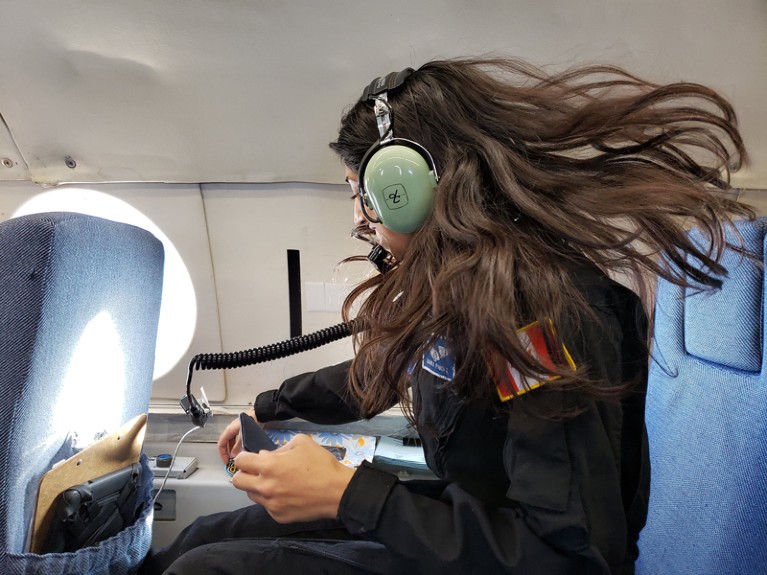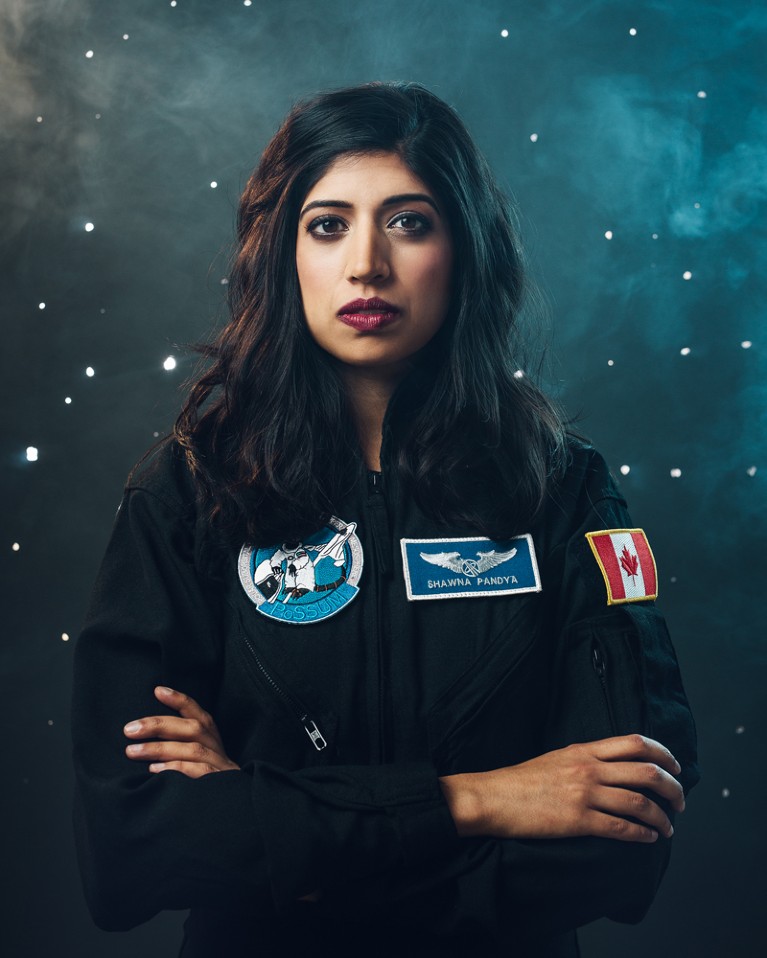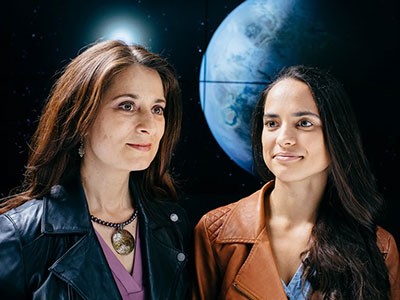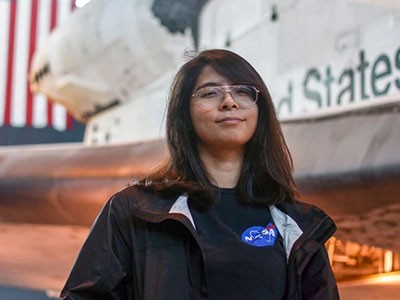
Shawna Pandya tests out virtual-reality medical platforms under microgravity conditions.Credit: IIAS
Growing up in the 1990s, Shawna Pandya watched Canada’s first female astronaut, medical doctor Roberta Bondar, fly into space. Pandya was captivated. So after earning a bachelor’s degree in neuroscience from the University of Alberta in Edmonton, Canada, in 2006, she pursued a master’s at the International Space University in Strasbourg, France, graduating in 2007. She completed a degree in medicine at the University of Alberta in 2012. Now, alongside a career in emergency medicine with Alberta Health Services in Edmonton, Pandya juggles mission training with entrepreneurial activities. She tells Nature about some of the business opportunities her career has led to, and how technological innovation for medicine in space might also help to deliver better health care in remote settings on Earth.
What entrepreneurial activities are you involved in?
I’m currently the vice-president of immersive medicine at Luxsonic Technologies, based in Saskatoon, Canada, a start-up company that leverages immersive technologies such as virtual reality (VR) 360° video and extended or mixed reality, for delivering health care.
What is immersive virtual-reality medicine?
Immersive is an umbrella term for technologies that immerse the user in a 3D environment. For example, a rural physician working in a small community doesn’t have space to support a conventional medical-imaging reading room, but the lack of physical space for high-resolution monitors can be overcome with virtual reality. In this way, radiologists working remotely can still read images for their cases. The COVID-19 pandemic prompted proof-of-application for this.

Pandya, an emergency-medicine physician, argues that we need much more research on how space affects women’s bodies during long-term missions.Credit: Cooper & O'Hara
How would virtual-reality medicine be used in space?
I like to call the challenge involved in packing for trips to space the Aladdin principle: infinite cosmic power to get to space; itty-bitty living space once we get there. Space-packing principles mean low mass, low volume, low cost, long shelf life and easy to use. A virtual-reality radiology reading room meets packing constraints — low mass, volume and power — yet with resolution equivalent to that of a conventional reading room for physicians and crew medical officers to analyse images.
On the training side, skill deterioration and loss of expertise are risks on long-duration missions. Imagine if, as a crew medical officer who learnt to put in an intravenous line on Earth, you’re not called on to use that skill until you arrive on Mars nine months later. If you haven’t practised, that muscle memory will deteriorate and your patient could end up looking like a pincushion. Rather than create a physical simulation with mannequins, you can recreate the situation in virtual reality with a Luxsonic platform called CaregiVR.
Mother–daughter duo work together to find new worlds
What other products have you been involved in at Luxsonic?
First, we have SieVRt, which is a virtual-reality mock-up of all of the high-resolution monitors and back-end tools that radiologists need to interpret medical images. This ‘digital twin’ of a radiology reading room eliminates bulky infrastructure.
I first tested the SieVRt suite technology on an aquanaut mission, a space simulation conducted in a training capsule under water at the Jules’ Undersea Lodge in Key Largo, Florida. As a crew medical officer, I had a virtual meeting with Paul Babyn, then the head of medical imaging at the University of Saskatchewan’s Royal University Hospital in Saskatoon, more than 4,400 kilometres away, to review a shoulder blade fracture in a simulated trauma patient. I then ‘flew’ that SieVRt suite in zero gravity to test its readiness for space. Later, at the Canadian Space Agency (CSA) National Space Health Forum, Luxsonic’s chief executive requested my expertise in space and extreme environments to develop other procedures for long-duration missions.
Another product I’ve been involved in is virtual-reality modules for training and skills practice used by search and rescue personnel, laboratory technicians, paramedics and advanced trauma life-support personnel.
What skills from your training translate to your entrepreneurial roles?
For my work both at Luxsonic and as a medical adviser for other companies — such as Above: Space Development — the number-one translatable skill is clinical knowledge of emergency-room care. For example, when building a virtual-reality medical module for resuscitation in the trauma bay, it’s crucial to know the sequence of skills required, plus details such as the placement of monitors, the biohazard disposal bin and personal protective equipment.
Another example is translating English to developer language — what developers need to program a virtual-reality module.
How do you balance your entrepreneurial roles with your astronaut duties and medical career?
My life is like a box of chocolates — I never know what I’m going to get. Typically, I cover a small-town hospital from 5 p.m. on Friday to 8 a.m. on Monday. On Tuesdays, I practise primary care at an urban clinic, focusing on women’s health. The rest of the week I focus on Luxsonic duties, my position as director of the International Institute for Astronautical Sciences’ space-medicine group, and research from missions. For example, data from the second NEPTUNE underwater mission that we finished in May contributed to research on engineering synthetic skin, testing SieVRt and studying how the eye changes under pressure. So every day is a little different. There’s no nine to five, five days a week. It’s seven days a week. I’m working on a plane, in airports, wherever I can. I do it because I love it.
Historically, space science has lacked diversity. What changes are needed to make a real difference in human exploration?
I’m a big fan of the expression ‘don’t do it for me, without me’. Everything is a new frontier because only around 600 people have ever been to space. About 12% of those people were female, with just 1% of them Black women. We definitely need more data; 12% is an almost-embarrassing minority. There is a now-infamous story about Sally Ride being sent into space with 100 tampons for a 6-day trip. For me, that lack of understanding is a point of contention.
For example, female astronauts often take hormonal contraceptives to stop their cycles in space. I was once talking to a senior medical employee at NASA and I asked “How messy does it get?” He said that the blood clogs up the toilet. I responded, “What!? You would rather women re-engineer their bodies than engineer a better toilet? You’re NASA! Engineer a better toilet!”
The bottom line is that further study is needed to understand the consequences of space travel on women’s bodies. Studies have shown that female rodents have had problems with ovulation, miscarriages and other sex differences because of the impact space has on biology.
What advice would you give to young people curious about a career in space science?
This is the most exciting time to be part of human space flight and exploration. Access is unparalleled. We need all comers. So whether that’s marketing, storytelling, policy, science or medicine — pick what you’re passionate about — aim to be the best, work hard to get there, and don’t let anyone tell you that you don’t belong. There is absolutely space for you.


 The Indigenous rocketeer
The Indigenous rocketeer
 How my training helps me to address health disparities in multiple myeloma
How my training helps me to address health disparities in multiple myeloma
 Mother–daughter duo work together to find new worlds
Mother–daughter duo work together to find new worlds
 Careers advice from scientists in industry
Careers advice from scientists in industry








